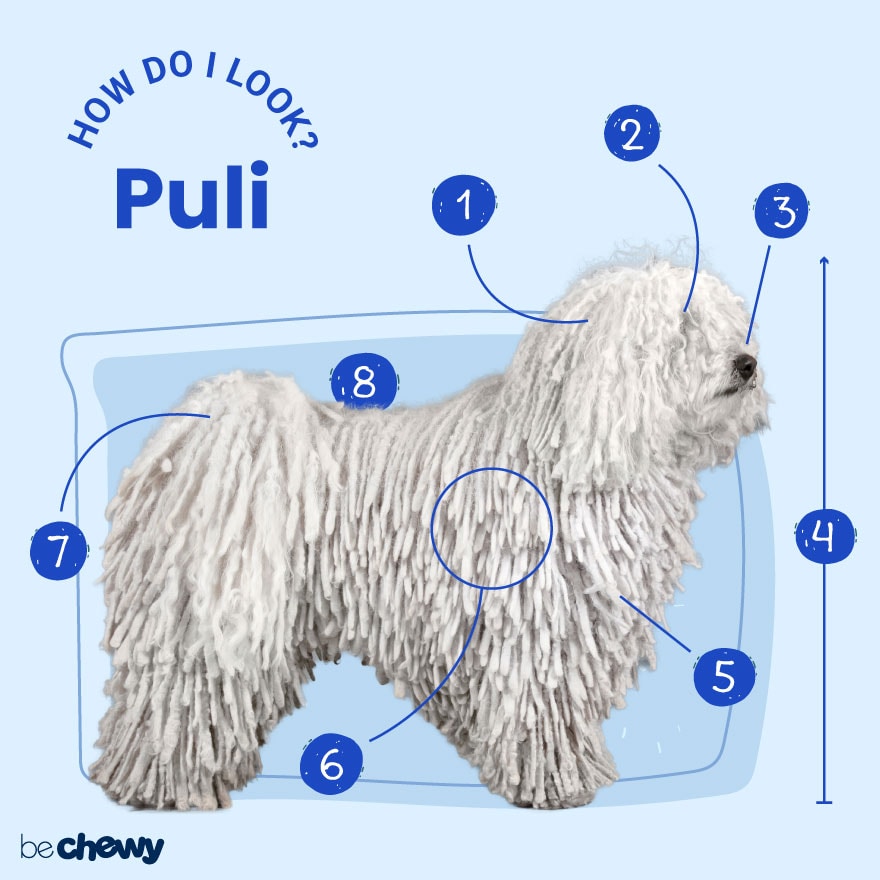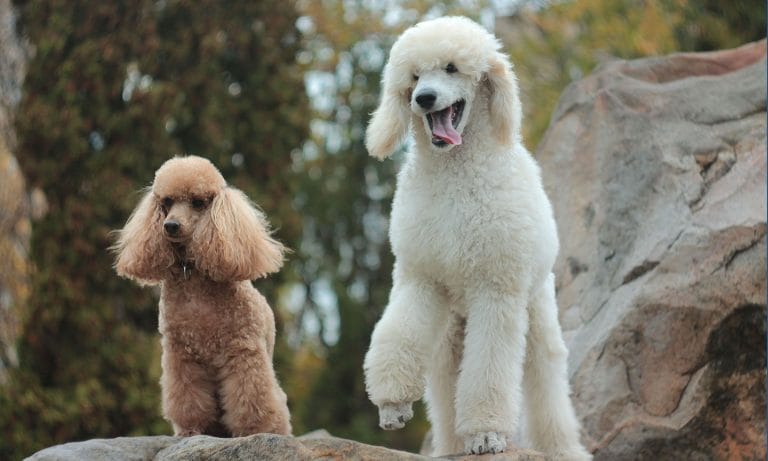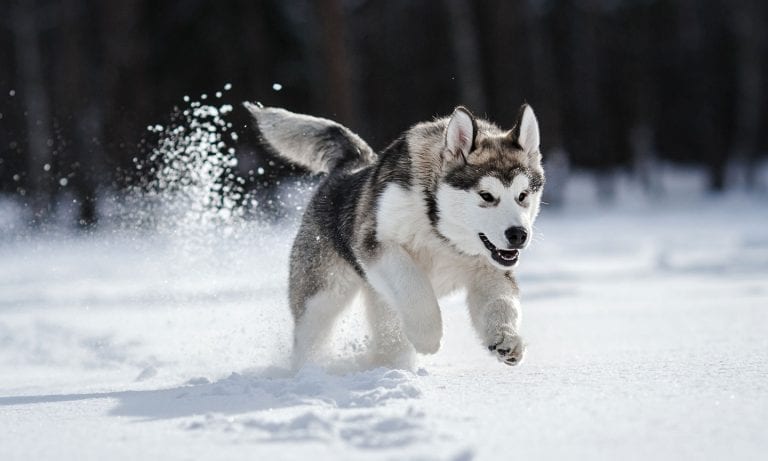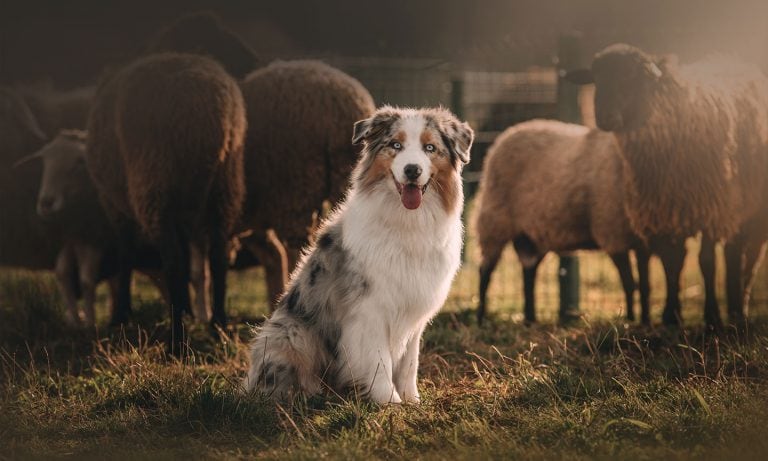It can be hard to see a Puli’s eyes through their corded fur—but that doesn’t mean a Puli can’t see yours. And you know what? They love what they see. Pulik (the plural term for these devoted dogs) are ready to play at the word go. You can expect this super clever—and sometimes sneaky—breed to figure out how to get you off the couch and into the Great Outdoors. The Puli is perfect for you if you’re a kid at heart—they remain playful and curious long after puppyhood.
Breed Snapshot
Temperament:
ConfidentIntelligentPlayfulCoat Color:
BlackSilverWhite
Best For
Puli dogs are intelligent and playful pups who require daily grooming and lots of exercise. They thrive in spacious homes with active and experienced pet parents, even those with dog allergies—this breed is considered hypoallergenic.
Puli Temperament
Just like you, the Puli is one of a kind. With their unmistakable long cords (which people sometimes mistake for dreadlocks), a fun-loving but sometimes ornery attitude and eager-to-please personality, Pulik are loyal dogs who live for fun with their favorite human (that’s you!).
The Puli breed has its roots in Hungarian sheepherding, and today, the herding instinct remains strong. That means early socialization and basic obedience training (skills like sit, stay and come) are essential to raising a confident adult Puli dog. This intelligent breed loves using their brains, so they’re also happy to learn advanced skills.
Though strong-willed, thanks to being bred to work independently, Pulik are dedicated to their family. They are naturally protective and can be wary of strangers, which makes them good guarding dogs. However, they generally get along well with people (once they get to know them) and other dogs. The downside to having the long corded fur is that when it covers their eyes and disguises the tail and ears of the Puli, it can be difficult for other dogs to read their body language—the primary way dogs communicate. If only dogs could pass notes to each other. (“I like you, do you like me? Check a box: Yes or No.”)
A Puli dog can live with a cat; it helps if they grow up together and pet parents set boundaries to prevent the dog from giving into their herding instincts and chasing the cat. Same with young children—your Puli may try to keep your children from straying too far away or wandering around the house, but training can help. Children in your Puli’s life should also be taught to play respectfully with dogs.
Pulik need a lot of mental and physical stimulation—no couch potatoes allowed, and don’t be stingy with the walks, either! Long walks, puzzle toys in the house, or an agility or herding dog class will keep your Puli satisfied and help them put their best paw forward daily.
How to Care for a Puli
The most significant aspect of Puli breed grooming is that their long, corded fur requires daily care. Even if you decide to leave the coat shaggy, you’ll still have to brush it at least weekly. The breed also has higher daily exercise needs than many other breeds. Pulik are generally healthy dogs that can live into their teens with the proper nutrition and care.
Puli Health
A Puli’s life expectancy is 10 to 15 years. They are generally healthy, but if you get your puppy from a breeder, ensure they follow the Puli Club of America guidelines and screen for common health issues.
- Hip Dysplasia: Hip dysplasia is a genetic condition in which the hip joint doesn’t form properly. It can cause lameness and pain in your dog. Many treatments and therapies are available, including weight management, restricting activities, physical therapy and medication. Sometimes, surgery is required.
- Patellar Luxation: Patellar luxation is common in small to medium-sized dogs. It occurs when a dog’s kneecap slips out of the joint, which can cause arthritis or joint problems in the hips and other legs. You can manage it by keeping your dog at a healthy weight and curtailing strenuous exercise if it’s not severe. If it becomes severe, surgery may be necessary.
- Degenerative Myelopathy: Degenerative myelopathy is a disease that affects the spinal cord. It slowly progresses, causing weakness and paralysis in a dog’s back legs. It is similar to Lou Gehrig’s Disease in humans and is most common in middle-aged dogs. There is no effective cure, but managing the weight of your Puli and keeping them as active as possible can help.
- Eye Problems: Pulis can develop cataracts, which cloud the eye and lead to blindness. Surgery may be an option for cataracts. They can also inherit progressive retinal atrophy (PRA), which causes the dog to go blind. There is currently no treatment for PRA, but pet parents can make accommodations to help dogs who lose their vision, such as avoiding changing the layout of their homes.
Puli History
While no one knows the Pulik’s origin for sure, it’s thought the breed was brought to Europe more than a thousand years ago by a nomadic tribe called the Magyars in the region now known as Hungary. The breed herded flocks of sheep on the Hungarian plains, developing its trademark corded coat to help protect them from frigid winters.
Starting in the 17th century, the number of Pulik dwindled and almost disappeared, but Dr. Emil Raitsits, professor at the Hungarian University of Veterinarian Medicine, revived the breeding of Pulik and established the breed standard between 1912-1915 so they didn’t become a lost part of canine history.
The Puli was brought to the United States in 1935 as part of a study by the US Department of Agriculture to find a breed that wouldn’t harm the animals they were supposed to be herding. They mixed Pulik with other breeds and kept some purebred, but the program yielded nothing definitive. After World War II, the Pulik were auctioned off to breeders, becoming the pets we know today.
The American Kennel Club recognized the Puli in 1936. You can find a list of reputable breeders on the AKC’s website. Working with a reputable breeder usually means you’re getting a Puli puppy who’s been screened for health problems and temperament. Depending on the breeder, a Puli can range from $1,200 to $2,000. You can also contact the Puli Club of America Rescue Trust, keep an eye out for the breed at your local animal shelter, or search Chewy’s database of adoptable dogs in your area.
FAQs
Why do Puli dogs have dreadlocks?
Puli cords, sometimes mistaken for dreadlocks, naturally occur in this breed due to their wooly, dense undercoat and coarse outer coat. Around 8 to 10 months, the soft undercoat starts to come in, and the cords begin to form, though you will have to put in some work to separate the cords throughout your Puli’s life.
Do Puli dogs shed?
No, Puli dogs don’t shed, and their fur turns into cords. They are considered hypoallergenic.
How long do Puli dogs live?
Puli dogs have a life expectancy of 10 to 15 years on average.
Are Puli dogs able to see?
Puli dogs can see just fine, though their long corded hair often covers their eyes!
How big does Pulis get?
Pulik grow to about 25 to 35 pounds and can get up to 17 inches tall at the shoulder. They are considered a medium-sized breed.
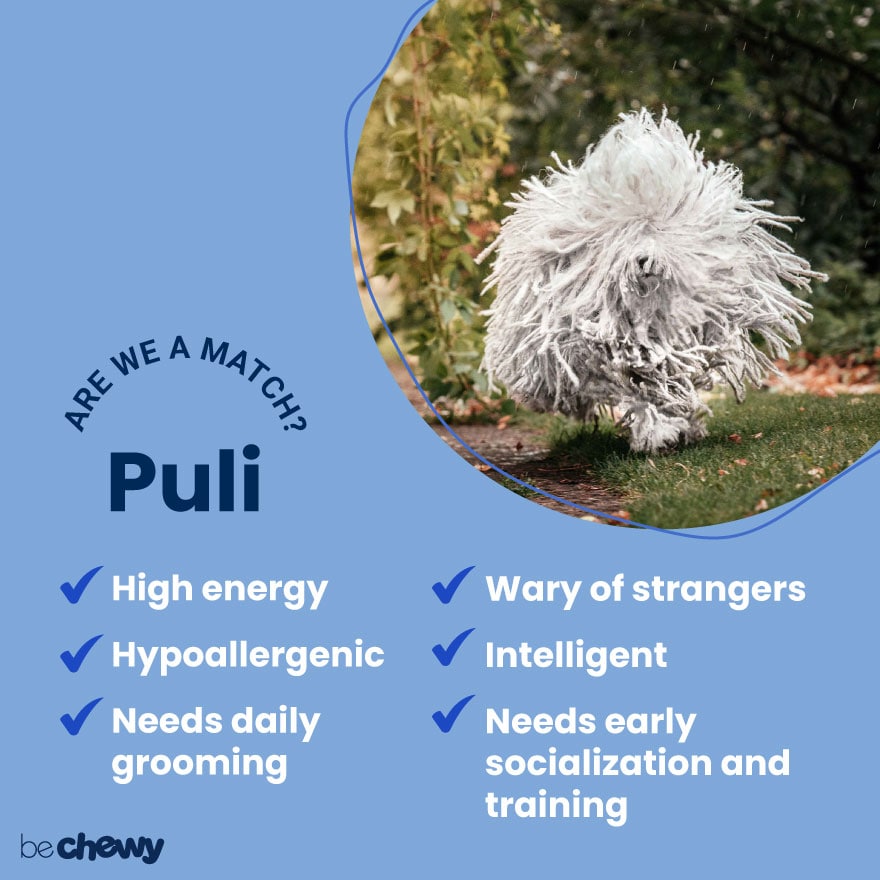
Top Takeaways
This intelligent breed who loves to work is ready to be your new best friend. Pulik love to spend time with their family, whether it’s herding, an agility class or training. Their corded fur requires daily grooming but is also hypoallergenic. Active pet parents looking for a devoted dog to explore the Great Outdoors with, look no further than the eyes of the Puli—if you can see them, that is.
Expert input provided by veterinarian Dr. Ann Hohenhaus, staff doctor at NYC’s Animal Medical Center, and certified dog trainer Russell Hartstein, CDBC, CPDT-KA, and owner of the LA-based Fun Paw Care.
Breed characteristic ratings provided by Dr. Sarah J. Wooten, DVM, CVJ, a veterinarian at Sheep Draw Veterinary Hospital in Greeley, Colorado; dog trainer and behavior consultant Irith Bloom, CPDT-KSA, CBCC-KA, CDBC, owner of The Sophisticated Dog, LLC, in Los Angeles; and certified animal behavior consultant Amy Shojai, CABC, in Sherman, Texas.
The health content was medically reviewed by Chewy vets.

Search for Adoptable Pulis Near You
Female Names
- Pepper
- Daisy
- Noma
- Cuki
- Willow
- Harpo Michelle
- Misha
- Luna
- Scout
- Dot
Male Names
- Sweetie
- Oliver
- Louis
- Marley
- Finnegan
- Cain
- Denver
- Max
- Marley
- B
Share:




